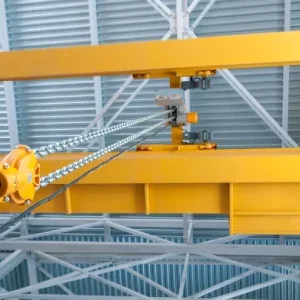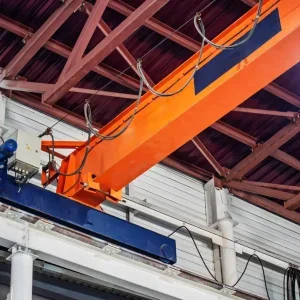British Standard BS 7121-2 – Code of practice for the safe use of cranes, deals specifically with inspection, testing and examination. In this context, inspection refers to the pre-use checks, including those done on a daily or weekly basis. These are normally carried out by suitably trained personnel employed by the user organisation. The term examination refers to the thorough examination, a higher level and more formal inspection usually carried out by an external ‘Competent Person’.
I am aware that, for some time, there has been concern about the quality of some thorough examinations. In fact, a year ago, I wrote about the problems of access to critical parts arising from modern designs of crane coupled with the current requirements for safe working at height. I believe that this is one of the causes of some inadequate thorough examinations.
The current edition of BS 7121-2 is dated 2003 and it is due for review. It is therefore an opportune time to open the debate about what constitutes a thorough examination and when it should be made, particularly in the context of factory cranes and hoists. The standard defines a thorough examination as:
‘examination by a competent person in such depth and detail as the competent person considers necessary to enable them to determine whether the equipment being examined is safe to continue in use.’
A footnote reminds us that:
‘The thorough examination is not part of the maintenance regime for the equipment but provides owners with information which could be used to determine the effectiveness of the regime.’
In other words, if the thorough examination reveals that the equipment is not safe to continue in use, it indicates that the in-service inspection and maintenance regime may not be adequate and should be reviewed.
The term ‘Competent Person’ is used to identify the person making the examination and the standard defines the term as:
‘person who has such practical and theoretical knowledge and experience of the lifting equipment to be thoroughly examined which enables them to detect defects or weaknesses and to assess their importance in relation to the safety and continued use of the lifting equipment’.
The UK legislation has never had any official system for appointing this person so therefore anyone who can show adequate evidence of competence can undertake the job. The Lifting Operations and Lifting Equipment Regulations (LOLER) use the term in several contexts and quite simply it means someone who is competent for the purpose of the particular regulation.
To help explain ‘competence’ in the context of thorough examination, the Lifting Equipment Engineers Association (LEEA) regards it as having three main components: theoretical knowledge; practical experience and personal attributes. The definition in the standard embraces the first two but perhaps the latter needs further explanation.
Personal attributes embraces several important matters. The person must be able to access the equipment, which may well involve climbing access ladders and therefore be trained in work at height and the use of appropriate personal protective equipment (PPE). They must have adequate eyesight, normally corrected by the use of spectacles if necessary. They must be able to communicate with the people they are dealing with and work with honesty, integrity and impartiality. The structure of the organisation they work for and its relationship with the equipment owner must be such as to avoid any pressures which might compromise that impartiality.
In the absence of any official system of appointment, in 1959 the LEEA introduced its own diploma qualification to assess theoretical knowledge, a system still operating very successfully 50 years later. More recently we have introduced practical training courses to complement the theory and contribute towards providing the practical experience. Earlier this year the LEEA also launched a new registration scheme, which involves ‘TEAM’ (Test, Examine and Maintain) identity cards being issued to engineers that have passed the Diploma.
The Lifting Operations and Lifting Equipment Regulations 1998 continued the requirement for periodic thorough examination contained in earlier legislation but introduced the option of an examination scheme. This was new to lifting equipment but was already established for other types of equipment, notably pressure systems. Surprisingly, despite offering the opportunity to focus resources onto the most critical parts of cranes, this option has not been widely used.
LOLER also introduced the requirement for the thorough examination report to state the date by which the next thorough examination must be made. This emphasises the fact that the specified periods are maximums and may need to be reduced. In practice they rarely are and most reports for cranes simply show a date twelve months from the date of examination.
Factory cranes, whether they are overhead gantry cranes or slewing jib cranes, generally have a long life of several decades. During that period the duties to which they are put can vary enormously with the fortunes of the factory owner. If the business flourishes, cranes designed for moderate use on a single shift system and only occasionally lifting their maximum load can easily be used more frequently, for longer hours, with average loads nearer to the maximum.
The in-service inspection and maintenance regime should be adjusted accordingly as should the frequency of the thorough examination. However there is often a tendency to ignore significant changes in crane duties resulting in more frequent breakdowns and other incidents. When the thorough examination is eventually made, the crane can be in a poor state of repair and, in the worst case, have defects which are of immediate or imminent danger. In such cases LOLER places a legal duty on the person making the examination to send a copy of the examination report to the enforcing authority.
To do a thorough examination properly takes time and, as we are all aware, time is money. Adequate time is needed but it has to be well spent. Let us look at what is involved in a thorough examination of a typical overhead gantry crane and a slewing jib crane.
Generally there will be local site rules dealing with permission to work and safety related issues. Assuming that these are complied with the first matter is to check the details of the crane against the records and review the last examination report. Enquire about any defects, malfunctions, other incidents, repairs and modifications which have occurred.
Operate the crane under no load through all its motions. This should be to the limits of each motion. For example, the hoist motion should ensure that the upper and, if fitted, lower limit switches operate at the correct positions and that the hoist mechanism operates smoothly. Listen for any sounds which might indicate a problem.
Similarly operate the cross travel and long travel motions of a gantry crane along the whole length of the bridge and gantry in both directions. Check all limit switches and any anti-collision devices, watch for smooth running and listen for any abnormal sounds from wheels binding on the track which might indicate gantry misalignment. The speed of travel should look and sound the same irrespective of the direction of travel.
Gantries can go out of alignment, particularly if they are part of the building structure and therefore subject to the influences of weather and other forces on the building. Within certain tolerances, gantries must be level along their length and across the rails from side to side, be parallel and the rails must lie flat. Any misalignment can cause damage to wheel flanges and the crane structure. Any indications of problems should be investigated further.
For slewing jib cranes, travel the block along the jib arm to the maximum radius and position the arm at each extremity of its arc of slew and at the centre point. Check that it doesn’t have a tendency to slew of its own accord from any of these points. Any tendency indicates a misalignment of the bearings which requires attention. Again this can occur over time, particularly with cranes mounted on the building columns. At each point, travel the hoist in both directions along the arm and check that there is no tendency for the trolley to run away.
For the next stage it will be necessary to isolate the power to the crane. Examine close up the structure of the crane and gantry rails for damage, cracks, wear, distortion, corrosion, loose bolts and missing parts – particularly end stops and buffers. For slewing jib cranes that includes the slew bearings. This requires good access to all parts, good lighting and, if necessary, the means to clean critical areas.
Next comes the close up examination of each of the motion mechanisms, looking for signs and symptoms of potential problems. For each motion check the motor, gearing and transmission, bearings, brakes, wheels, covers, guards and power conductors, particularly the flex points on festoon feeds and cable glands.
On the hoist motion, also check the condition of the hoist drum, rope spooling mechanism and any compensating mechanism. The condition of the wire rope or chain must be carefully checked, bearing in mind that it is likely to be worst at those points where it engages most frequently with the rope sheaves or load chain wheel. For this purpose BS 7121-2 includes twenty very helpful colour illustrations of typical wire rope defects.
The condition of the hook and any associated sheaves and sheave block assembly is critical. Damaged hooks can indicate overload and particular attention should be paid to the condition of the hook shank, screw thread and swivel components, especially on outdoor cranes where the ingress of water can cause failure.
Any audible and visual warning devices should be checked. The emergency stop function must also be tested.
Last but not least is the condition of the controls themselves and, for cab controlled cranes, the condition of the cab and all access ladders and walkways. Controls must operate smoothly and be free from wear and damage. Simple defects such as holes in the rubber boots and gaiters which protect buttons and levers can result in unintended and potentially dangerous commands. Unclear markings on the motion controls can lead to operator error.
Arising from what is outlined above and depending on the results, further action may be required. For example, opening up a noisy gearbox for further investigation, using NDT on suspected cracks, tightening or replacing loose bolts, replacing worn components, re-aligning the gantry or carrying out a load test. The examiner may also ask for evidence of electrical safety tests and calibration checks on any load indicator or limiter.
From the above I hope it can be seen what is meant by the terms thorough examination and competent person, what is the basis for deciding the intervals between thorough examinations, what is involved in the actual examination and what it can reveal about the adequacy of the in-service inspection and maintenance regime.
About the author
Derrick Bailes is technical consultant (formerly chief executive) for the Lifting Equipment Engineers Association, 3 Osprey Court, Kingfisher Way, Hinchingbrooke Business Park, Huntingdon, PE29 6FN, tel: +44 (0)1480 432 801, fax: +44 (0)1480 436 314, email: info@leea.co.uk
For more info
Check out an archive of Bailes’ long-running series on our website at www.hoistmagazine.com/leea






